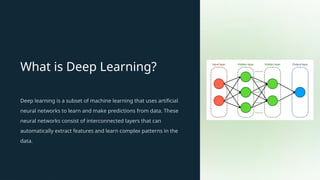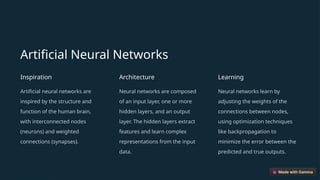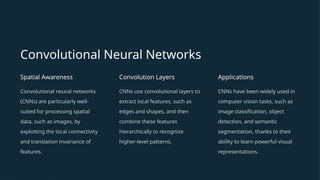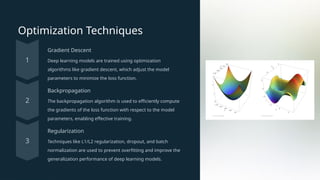Deep-Learning-Basics-Introduction-RAJA M
- 1. Deep Learning Basics Deep learning is a powerful machine learning technique that has revolutionized fields like computer vision, natural language processing, and speech recognition. This presentation will provide a comprehensive overview of the key concepts and applications of deep learning. M.RAJA AP(Sr.G) EIE KEC
- 2. What is Deep Learning? Deep learning is a subset of machine learning that uses artificial neural networks to learn and make predictions from data. These neural networks consist of interconnected layers that can automatically extract features and learn complex patterns in the data.
- 3. The Rise of Deep Learning Deep learning has seen a surge in popularity and success in recent years due to the availability of large datasets, increased computational power, and advancements in neural network architectures. This has led to breakthroughs in areas like image recognition, language translation, and game-playing AI.
- 4. Artificial Neural Networks Inspiration Artificial neural networks are inspired by the structure and function of the human brain, with interconnected nodes (neurons) and weighted connections (synapses). Architecture Neural networks are composed of an input layer, one or more hidden layers, and an output layer. The hidden layers extract features and learn complex representations from the input data. Learning Neural networks learn by adjusting the weights of the connections between nodes, using optimization techniques like backpropagation to minimize the error between the predicted and true outputs.
- 5. Activation Functions 1 Sigmoid The sigmoid function is commonly used to introduce non-linearity and map the output to a range of 0 to 1, representing the probability of a binary classification. 2 ReLU The Rectified Linear Unit (ReLU) is a popular activation function that applies a simple thresholding operation, setting negative inputs to 0 and passing positive inputs unchanged. 3 Tanh The tanh function is similar to the sigmoid function, but it maps the input range to [-1, 1], which can be more useful in certain applications.
- 6. Feedforward Neural Networks 1 Input Layer The input layer receives the raw data, such as images or text, and passes it to the hidden layers. 2 Hidden Layers The hidden layers extract features and learn representations from the input data, transforming it through a series of linear and non-linear operations. 3 Output Layer The output layer produces the final predictions or classifications based on the learned representations from the hidden layers.
- 7. Convolutional Neural Networks Spatial Awareness Convolutional neural networks (CNNs) are particularly well- suited for processing spatial data, such as images, by exploiting the local connectivity and translation invariance of features. Convolution Layers CNNs use convolutional layers to extract local features, such as edges and shapes, and then combine these features hierarchically to recognize higher-level patterns. Applications CNNs have been widely used in computer vision tasks, such as image classification, object detection, and semantic segmentation, thanks to their ability to learn powerful visual representations.
- 8. Recurrent Neural Networks Sequence Modeling Recurrent neural networks (RNNs) are designed to process sequential data, such as text or speech, by maintaining a hidden state that captures the context from previous inputs. Memory and Time RNNs can remember and utilize information from earlier parts of the sequence, allowing them to model dependencies and patterns in time-series data. Language Modeling RNNs are widely used in natural language processing tasks, such as language modeling, machine translation, and text generation, due to their ability to capture long-term dependencies in language.
- 9. Optimization Techniques Gradient Descent Deep learning models are trained using optimization algorithms like gradient descent, which adjust the model parameters to minimize the loss function. Backpropagation The backpropagation algorithm is used to efficiently compute the gradients of the loss function with respect to the model parameters, enabling effective training. Regularization Techniques like L1/L2 regularization, dropout, and batch normalization are used to prevent overfitting and improve the generalization performance of deep learning models.
- 10. Applications of Deep Learning Computer Vision Deep learning has revolutionized fields like image classification, object detection, and semantic segmentation, with performance surpassing human-level abilities in many tasks. Natural Language Processing Deep learning models have achieved state-of-the-art results in language modeling, machine translation, text generation, and other NLP tasks. Speech Recognition Deep learning-based speech recognition systems have significantly improved accuracy and performance, enabling natural and robust speech-to-text conversion. Robotics and Control Deep learning is used in robotics for tasks like object manipulation, navigation, and decision-making, allowing robots to perceive and interact with their environments.




![Activation Functions
1 Sigmoid
The sigmoid function is
commonly used to
introduce non-linearity
and map the output to
a range of 0 to 1,
representing the
probability of a binary
classification.
2 ReLU
The Rectified Linear
Unit (ReLU) is a popular
activation function that
applies a simple
thresholding operation,
setting negative inputs
to 0 and passing
positive inputs
unchanged.
3 Tanh
The tanh function is similar to the sigmoid function, but it
maps the input range to [-1, 1], which can be more useful
in certain applications.](https://image.slidesharecdn.com/deep-learning-basics11-241111123634-2d33c3cb/85/Deep-Learning-Basics-Introduction-RAJA-M-5-320.jpg)




